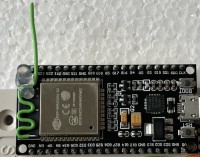ESP32 RANGE EXTENDER

An additional wire for a wireless device :-) to extend the working range
When experimenting with ESP32 modules I wish I had a little more WIFI range reserve.
This could be achieved by adding an external antenna – but only a few modules are prepared for the connection of an external antenna.
In the end, to keep it as simple but effective as possible, I added a half-wave antenna wire to the original onboard antenna of the ESP32 module.
I have investigated and documented this in more detail here <HERE>
The original print antenna is a meander-shaped, inverted F antenna with 1/4 wavelength. It is a compromise between size, omnidirectional antenna pattern if possible, and power efficiency. My thought now was to increase the WIFI range of the module by a coupling between the on-board antenna and a newly added external half-wave antenna wire (AWG24 switch wire 0.5mm with {old=62mm} 58mm length {see update below} ). However, no irreversible changes or soldering should become necessary. So I hot glued the additional antenna wire directly to the board..
Modified versus unmodified modul:
I tested the effect of the additional antenna and recorded the WIFI strength under different conditions. Here I can show only a very short abstract of my experiments and results.
I wrote a few lines of code in ANNEX32 – a standalone BASIC interpreter/IDE that runs on two modules - modified and original. This compares the WIFI field strength measured by both devices in a Life Browser window. Module 1 (with additional antenna) logs its own WIFI RSSI and additionally requests a string with the logged RSSI from the second (unmodified) module. Thus this browser window always displays two sliding curves with the last 100 measurements = about 50 seconds.
Results:
It turns out that the signal is improved by at least 3 dB overall on the modified modules with an elongated non-angled antenna wire. Under very reflective conditions, I had an improvement of almost 10 dB.
However, the rough measurements also suggest that the better conditions find its counterparts in the nulls in the antenna pattern which are now somewhat more pronounced, as expected.
Conclusions:
Under given unfavorable conditions, this simple antenna modification cannot work miracles, but it can
This could be achieved by adding an external antenna – but only a few modules are prepared for the connection of an external antenna.
In the end, to keep it as simple but effective as possible, I added a half-wave antenna wire to the original onboard antenna of the ESP32 module.
I have investigated and documented this in more detail here <HERE>
The original print antenna is a meander-shaped, inverted F antenna with 1/4 wavelength. It is a compromise between size, omnidirectional antenna pattern if possible, and power efficiency. My thought now was to increase the WIFI range of the module by a coupling between the on-board antenna and a newly added external half-wave antenna wire (AWG24 switch wire 0.5mm with {old=62mm} 58mm length {see update below} ). However, no irreversible changes or soldering should become necessary. So I hot glued the additional antenna wire directly to the board..
Modified versus unmodified modul:
I tested the effect of the additional antenna and recorded the WIFI strength under different conditions. Here I can show only a very short abstract of my experiments and results.
I wrote a few lines of code in ANNEX32 – a standalone BASIC interpreter/IDE that runs on two modules - modified and original. This compares the WIFI field strength measured by both devices in a Life Browser window. Module 1 (with additional antenna) logs its own WIFI RSSI and additionally requests a string with the logged RSSI from the second (unmodified) module. Thus this browser window always displays two sliding curves with the last 100 measurements = about 50 seconds.
Results:
It turns out that the signal is improved by at least 3 dB overall on the modified modules with an elongated non-angled antenna wire. Under very reflective conditions, I had an improvement of almost 10 dB.
However, the rough measurements also suggest that the better conditions find its counterparts in the nulls in the antenna pattern which are now somewhat more pronounced, as expected.
Conclusions:
Under given unfavorable conditions, this simple antenna modification cannot work miracles, but it can
- slightly increase the range of the ESP module or
- improve a given less stable WIFI connection.
This improvement inevitably comes with the disadvantage of more pronounced directivity. It works best when the module has a fixed location and when there is a possibility to adjust the orientation of the module’s antenna relative to the antenna of the AP.
I have investigated and documented this in more detail <HERE>
If you want go extend the WIFI range of a ESP32-C3 SuperMini board, take a look at the LABs article „ESP32-C2 SuperMini Antenna Modification“



Updates from the author